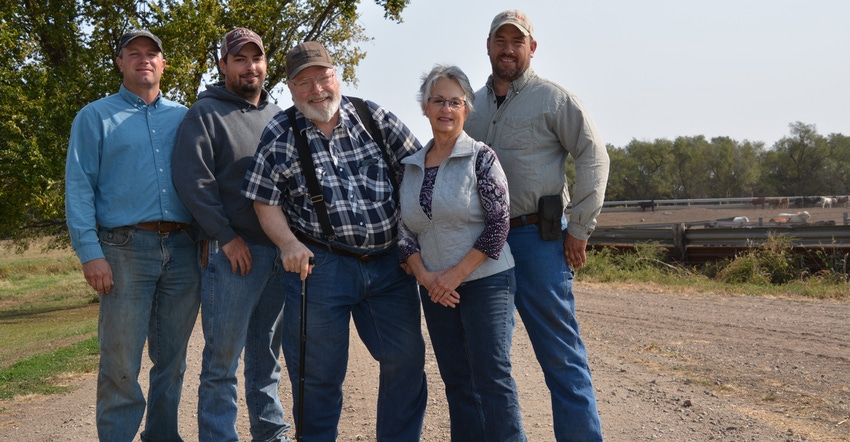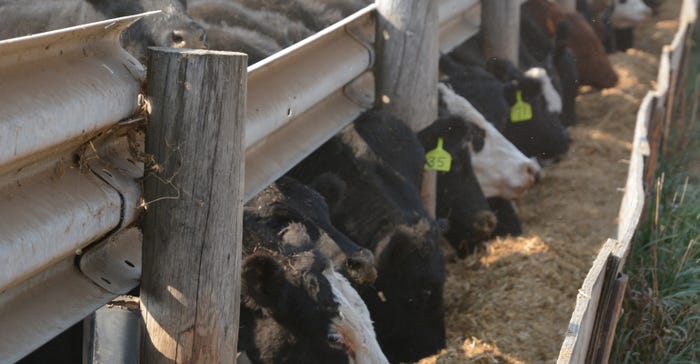December 9, 2020

Just a quarter of a mile separates Audrey Konechne from her children and grandchildren.
“Some grandparents talk about only getting to see their grandkids once every six months or once a year,” Audrey says. “It seems like there is always a grandkid playing here. I have never had an empty nest. Our oldest was home to farm with us before the last one was in school.”
She and her husband, James, spent years diversifying their operation so the next generation could return to the family farm near Kimball, S.D. Today, the farm business includes cow-calf, backgrounding, custom feeding and finishing operations, along with a hunting lodge.
Room to grow
The couple raised six children on the family farm, which was originally purchased in 1948 by James’ dad. Some of the land where they hunt and raise cattle and crops is the same land James’ dad, James Sr., bought in 1948 after returning from serving in the Army Air Corps during World War II. His dad handpicked corn in Minnesota for 3 cents per bushel and saved up. “He got started with $100 cash and borrowed horses,” James explains.
It was in 1976, after James graduated from South Dakota State University with an agriculture degree, that he started farming with his dad and his brother, David.
The family focused on caring for the livestock, land and wildlife. They implemented conservation practices like no-till farming long before it was commonplace.
“I was one of the first people in this area, and I kind of got laughed at,” James recalls. “It was a tough start. That first year, I was nervous to try something new, so the first field I tried it in was not along a road, thank goodness.” But by the second year, the 67-year-old farmer recalls having “tremendous luck and yielded 170 bushels of corn,” which was almost unheard-of in the early 1990s.
 MORE SPACE: To allow for the brothers to return to the farm, the Konechnes expanded the cattle feeding business. Today, the feedyard can hold up to 2,000 head.
MORE SPACE: To allow for the brothers to return to the farm, the Konechnes expanded the cattle feeding business. Today, the feedyard can hold up to 2,000 head.

In addition to no-till, the Konechnes added cover crops to their cropping rotation. “Cover crops are a tremendous asset,” James says. “Not only are they good for the ground, but they are also tremendous for livestock feed. Cattle love turnips and radishes. When we turn them out in the fall, they go after them like candy.”
Most crops raised on the Konechne farm end up as livestock feed. In addition to dryland corn, the family also raises rye, alfalfa, oats and forage sorghum. “In the area where we live, there is a lot of rough ground,” James explains. “Not exactly good farm ground. So, cattle are a good avenue for marketing our crops. We plant a lot of odds and ends that end up as silage.”
The cattle also graze down the pheasant food plots each spring — a practice his son, Kelly, says gets them in good shape for calving. “Since we started grazing food plots, we have not seen near the calving or health issues as we did in the past,” Kelly explains. “The cows are out there moving around, and the calves present themselves as they are supposed to, instead of backwards.”
Farm stays in family
Keeping the farm in the family has been one of James’ focuses for many years. When his oldest son, Chris, decided to return home to farm after receiving an agriculture degree from Mitchell Technical Institute, he began looking for ways to expand the family’s small feedlot operation.
“We started buying a few more small calves, fixing up an old yard, fixing up another old yard, building some new fence,” Chris says. “We expanded slowly. It was like taking an old house and adding on and adding on — and before you know it, we had room for 2,000 head.”
Since Chris first returned home, making it in the cattle business has become a lot more complicated. “When I think back to when I first started, it was easy,” he says. “As our operation has grown, the industry has also changed. There are too few people to sell the cattle to. The markets are controlled by too few active buyers.”
To remain competitive, Chris, along with his dad and brother, have modified their herd genetics. Today they raise smaller cows. “My goal is to sell pot-loads of cattle that are most attractive to buyers, weighing about 700 to 900 pounds,” Chris says
Happiest on the farm
Even though it’s challenging, farming is all Chris thought about. Now, his own children are helping. “Last spring when the kids were remote-schooling, our 8-year-old son, Leo, was more ambitious than me to want to get up and go out to work,” Chris says.
The work ethic is also one of the reasons, Chris’s wife, Amanda, is happy to raise their children on the farm. “The work ethic and hands-on skills, I feel, are important for our kids to learn,” Amanda says. “And regardless of where they end up one day, I feel like these are worthwhile skills to have.”
Kevin Konechne also lives on the farm, where he operates Diamond K Trucking. “I was looking for an opportunity to be self-employed,” Kevin explains. “I went to school for welding, and after four years in a factory, I got bored with it.” So, he started his own business.
“Grandpa started Box K Ranch,” he says. “I wanted to be different, so I turned the box a bit and made a diamond.”
Kevin and his wife, Heather, chose to live on the family farm because it is a good place to raise children. “I was raised on a farm by Watertown, and I absolutely loved it,” Heather says. “And I spent a lot of time with my grandparents, because Dad farmed with Grandpa, and they only lived a mile away — just like it is for us here.”
James and Audrey Konechne also have three children who live off the farm with their families. James says he is happy his sons continue the farming tradition. “The operation sure would not be going if I didn’t have the boys here,” he says. “I would have had to quit by now.”
For the brothers, it is a way to preserve the family’s farming legacy for the next generation. Chris and Amanda’s children are Leo, Violet, George and Jasper. The family only lives a quarter-mile from Kelly and wife Kayla and their children, Cadence, Carter, Olivia and Ty. Kevin and Heather are expecting their first child in 2021.
For Grandma Audrey, having her children and grandchildren just down the road is the greatest blessing from the farm.
Roti, a freelance writer for the South Dakota Farmers Union, writes from Sioux Falls, S.D.
You May Also Like




